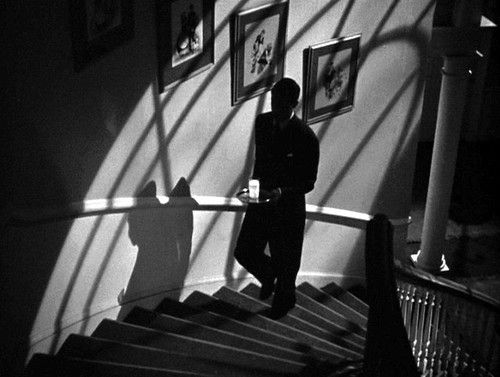Monthly Archives: April 2017
A brief note on misunderstanding Hitchcock’s Suspicion (1941)
Hitchcock’s second Hollywood outing, SUSPICION (1941), is probably most famous for its ending – an example of studio executives’ interference and retroactive aversion to portraying Cary Grant, in all his dashing glory, as a devious murderer. Hitchcock’s latter interviews with Truffaut display the director’s own post-mortem of a film which he felt would have been so much better, had it not been for the slight of hand from RKO pictures.
But – and I am in an unequivocal minority if IMDB is anything to go by here – I am rather of the opinion that the film’s coda as it stands represents something of a coup. Unlike its predecessor, REBECCA (1940), the photography is bright throughout SUSPICION (1941); it’s only with the passing of time and Fontaine’s descent into conjectured mistrust that the frames here darken, finally resulting in the iconic ‘glass-of-milk-up-the-staircase’ scene – one of the finest and statuesque sequences Hitchcock put on film. It’s this closing down of Fontaine’s world, and her grip on reality, which is the underlying story of the film. Convinced she’s about to be murdered, Fontaine flees for the sanctuary of her family home; unknowing of Grant’s genuine lack of murderous intent, before finally realising she’s entirely misunderstood events (just have we the audience) as Grant saves her from falling to certain death during the car journey there.

Of course, generations all assume that Cary Grant is the villain of the piece; but as our ‘odd’ mystery writer lets on earlier in the film, it’s the (would-be) murderers who are heroes in this genre. Joan Fontaine, a woman sodden with the paranoia meticulously tracked on camera, is actually the malefactor to Grant’s self-reflective libertine. This is the true meaning of the ‘studio’ ending, whether they meant it or not. And isn’t this all-the-more interesting in theme and narrative, than simply “that nice movie star is actually a cold-blooded killer?”.
Whilst I have a truck with the majority view of the ending, I am less-inclined to lavish a degree of praise such as to raise the rest of the film into the upper strata of the great director’s cannon. It’s not on the same level as STRANGERS ON A TRAIN (1951), ROPE (1948) and PSYCHO (1960) but it’s a better film than some of Hitchcock’s widely-acclaimed movies such as DIAL M FOR MURDER (1954) and TO CATCH A THIEF (1955), which rely mostly on a polished aesthetic alone. For example, the dynamic between Grant, Fontaine and Nigel Bruce as the ill-destined “Beaky” seems heartfelt here and the aforementioned 50s thrillers lack a degree of that playfulness.